
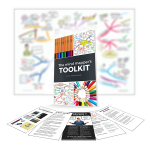 Update (February 2018): Since writing this post, I have completed degrees in law and psychology and a PhD with the help of mind maps.
Update (February 2018): Since writing this post, I have completed degrees in law and psychology and a PhD with the help of mind maps.
Now here’s the thing: I could not have got through my studies without mind mapping. I have created a free Mind Mapper’s Toolkit to help students use this great study strategy. You can get your FREE copy here.
_______________________________________________________________________________
This happened to me 6 years ago for my first open book test for law at university. Still to this day I can remember the awkward feeling of taking the test, flipping through my books wildly trying to find answers to the questions in front of me and having no idea what I was doing.
I knew that I didn’t get 5% because I was stupid. Walking out of that test I knew what was missing was an effective way to study. You see, I had managed to get good marks in high school by rote learning (spending hours and hours reading my text books and notes, and being able to repeat it like a parrot).
But I never really understood what I was learning, which could explain why I didn’t really enjoy my subjects and graduating from high school was such a relief!
For my next test for law (they gave me a second chance), all that I brought in with me was a bunch of simple mind maps. I remember feeling confident and in control doing that test. I got my test paper back and my score had jumped from 1 out of 20 to 15 out of 20. I’m now in my final semester of law, and I can honestly say that I don’t think I’d be here if it wasn’t for my mind maps.
They allow you to see the big picture (how all the different ideas are to connected to one another). I find that they also help me to clarify my thoughts, simplify complex ideas, memorise information and allow me to be creative so I don’t get as bored as easily.
Below is a step by step process on how you can create a mindmap. The example used is preparing an event (i.e. school ball), but you could mindmap anything else (e.g. subjects).

Step 1: Grab some coloured pens/pencils, a blank piece of paper and turn it sideways. In the centre of the page draw the first image that comes to mind on the topic you are mindmapping. Label the image.

Step 2: Branch off from your central image and create one of your main ideas (think of each branch as being like a chapter in a book). Label the branch. You can also draw a picture for it.
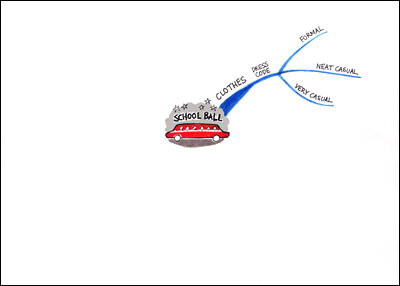
Step 3: From your main branches draw some sub-branches and from those sub-branches you can draw even more branches. What you are beginning to do is create associations between ideas.
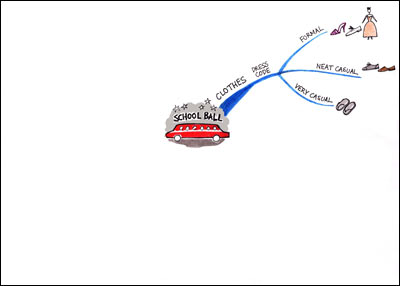
Step 4: Draw pictures for each branch or for as many branches as possible. Make each picture as absurd, funny and/or exaggerated as possible. The reason for this is that we think in pictures and remember vivid, exaggerated images more easily.

Step 5: Draw another main branch but this time use a different colour. Colour helps to seperate out different ideas and keeps your mind stimulated). Draw sub-branches and pictures. If you get bored at any stage, move on and create another branch.
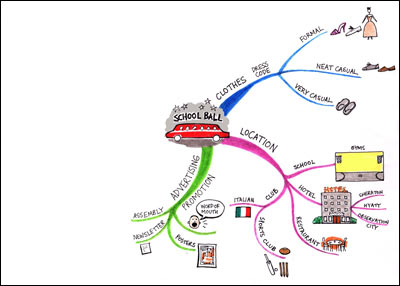
Stage 6: Keep repeating the above process (different colours, main branch, sub-branches and absurd pictures). Make sure each branch is curved and not a straight line. The brain is more stimulated by curved lines.

Step 7: Voila! You have created a mind map. Remember, it doesn’t have to be a work of art. Allow yourself to be as messy and creative as you like. It doesn’t matter if other people can’t understand your mind map. You just need to be able to.
If you’d like to see how mind maps have been used to simplify complex topics such as global warming, click here.
Share This:

When you start using this strategy, it can feel clunky and awkward. It requires some mental effort to get going.
Why can it feel hard to start mind mapping?
Because it isn’t a habit (not yet, anyway). But once mind mapping becomes a habit, it can feel easy and deeply rewarding.
So, how do you get to that point where mind mapping feels easy? Even fun?
In this article, I will explore how you can create a habit of mind mapping. I’ll show you how to remove friction or pain points so it’s much easier to put pen to paper and absorb ideas.
Let’s start by looking at what gets in the way and stops many people from creating mind maps in the first place. I’ll also share some strategies you can use to overcome each of these barriers.

When you look at a mind map with all the pictures and different colours, it seems like something that would take a fair amount of time and effort to create.
If you’re comparing mind mapping to the time it takes to read your book passively, then yes, mind mapping will take more time. But you need to understand that reading your book passively is not an effective way to learn. In contrast, mind mapping is super effective.
People often fall into the trap of trying to make their mind maps look like works of art. Try lowering your standards and allowing yourself to make a mess when you mind map. This will speed up the process.
Another time trap is trying to mind map as you read and trying to mind map everything you read. I find it’s much faster to read and tab key ideas worth mind mapping later on. Once I’ve finished reading either the chapter or book, I then commence the mind mapping process. By this stage, I have a better understanding of the key ideas and what’s worth mind mapping.
Some people get hung up on the way their mind maps look. They can’t stand looking at messy pictures and scribbled words. If that’s you, perhaps you could take your drawing skills to the next level with some practice and sketch classes. But it’s not necessary.
Mind maps are not there to look pretty. They are there to help you learn. I am a big fan of badly drawn mind maps. If you look at my mind maps from university, they’re not works of art but they contain loads of important ideas. And that’s what matters most when it comes to learning.
Here’s a simple hack: invest in a set of nice, vibrant coloured pens. A bit of colour on the page will make your mind maps more visually appealing.
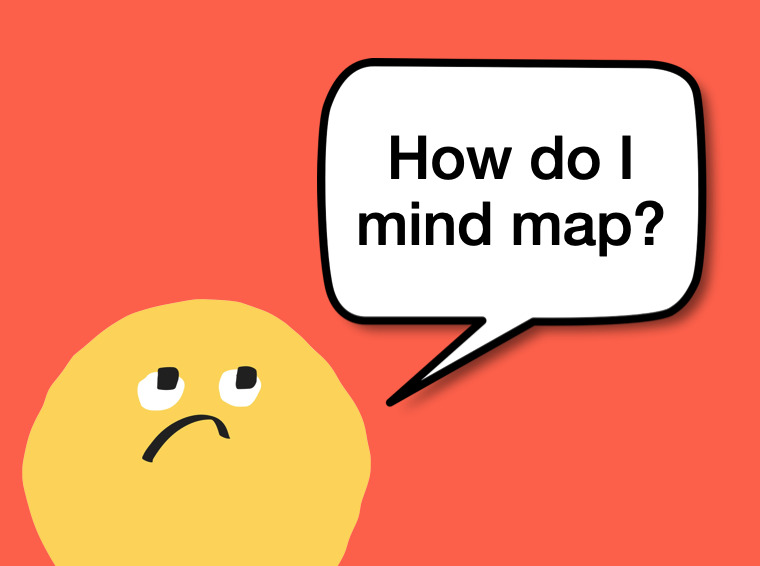
Mind mapping is straightforward. You draw a central image, curved lines, a few pictures, and write down key ideas. That’s it!
It’s not something you need to read a book about. You don’t need to enrol in a 10 week program to learn how to do this.
If you want some tips on how to mind map, check out my free Mind Mapper’s Toolkit. It’s a quick and easy read.
It’s important to realise that the first time you engage in any new behaviour, it will most likely feel strange and uncomfortable. You may feel a bit clumsy and awkward. You may have questions, “Am I doing this right?”. All of this is normal and to be expected.
Even something as simple as the pen you mind map with can make or break the mind mapping process.
You’ve probably noticed that some pens don’t feel pleasant to write or draw with. For instance, I’m not a fan of the popular Sharpie pen range. I don’t like the way these pens bleed through the page. And I really don’t like the way they smell.
These may seem like minor irritations and quirks, but trust me, they’re not. Your mind mapping experience will be diminished by a pen that doesn’t feel good in your hand or on the page. And any behaviour that feels unpleasant is much harder to sustain.
I’ve since ditched my Sharpie pens. I mind map with a uniball signo pen and non-toxic Tombow paintbrush pens. As far as coloured pens go, I won’t lie, these pens are pricey! But you can find them online for $25 cheaper than in Officeworks (a big stationery store in Australia).
What I love about these pens is that they are super easy to use, feel lovely to strike across the page, and they won’t leave you with a splitting headache from the ink smell.
Here are some things that have helped me to establish this habit in my life:
When is the best time for you to mind map? Where in your day can you easily slot in a 15 minute mind mapping session?
I like to mind map when I feel fresh and mentally alert (first thing in the morning).
Find an activity that you do every day without fail (e.g., having a shower, eating breakfast or dinner) and use that to prompt you to start a mind mapping session.
For instance, after I have completed my morning routine (workout, breakfast and shower), that’s my cue to sit down and start mind mapping.
Before you start your session, set yourself up with everything you need to mind map. I like doing this the night before my morning mind mapping sessions.
Before I go to bed, I lay out a sheet of A3 paper, my pens, and my timer. The book I am mind mapping is open on the page where I need to start working. The next day, all I need to do is sit down, start my timer, pick up a pen, and away I go!

What’s one thing that can slow down the mind mapping process?
For me, it’s digital distractions (e.g., text messages and notifications).
You probably already know the things that tend to derail you. Create a barrier between you and those things.
For example, my phone is the biggest distraction for me. How do I deal with this? Before I start mind mapping, I take my phone and place it away from my body in another room.
This signals to my brain that my phone is off-limits and it’s time to knuckle down and focus on my work.
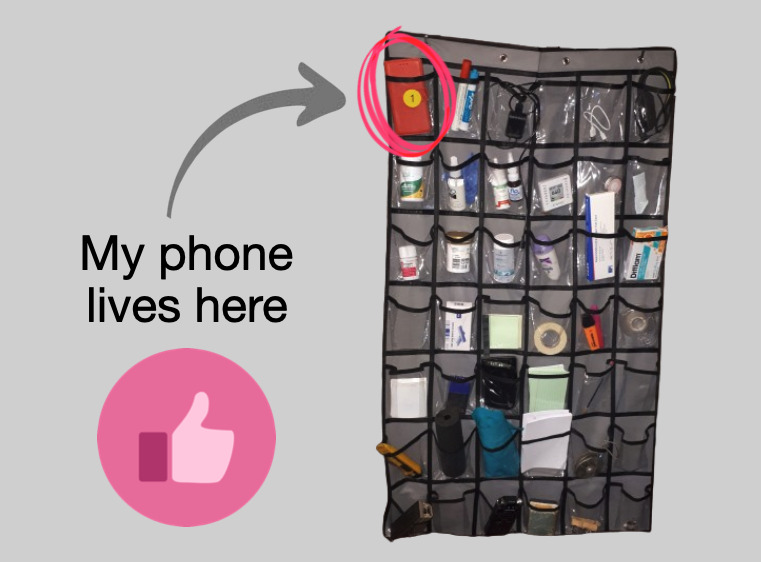
Don’t wait until you feel pumped and inspired to create a mind map. Set a timer for 10-15 minutes and start mind mapping (regardless of how you feel).
If you miss a day, don’t beat yourself up. It’s no big deal. Just say to yourself, “Tomorrow is a new day. I will get back into mind mapping then”.
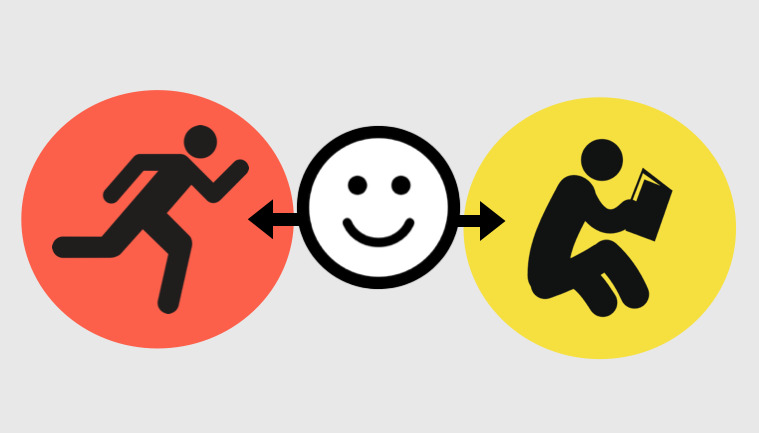
When the timer goes off at the end of your mind mapping session, say to yourself, “Good job!”. Do anything that makes you feel instantly good. I often clap my hands or do a fist pump.
According to Professor BJ Fogg, the secret to wiring in any new habit is to release a positive emotion within milliseconds of engaging in the new behaviour. When you release positive emotions, this releases dopamine in your brain. This makes it more likely that you’ll engage in this behaviour again.
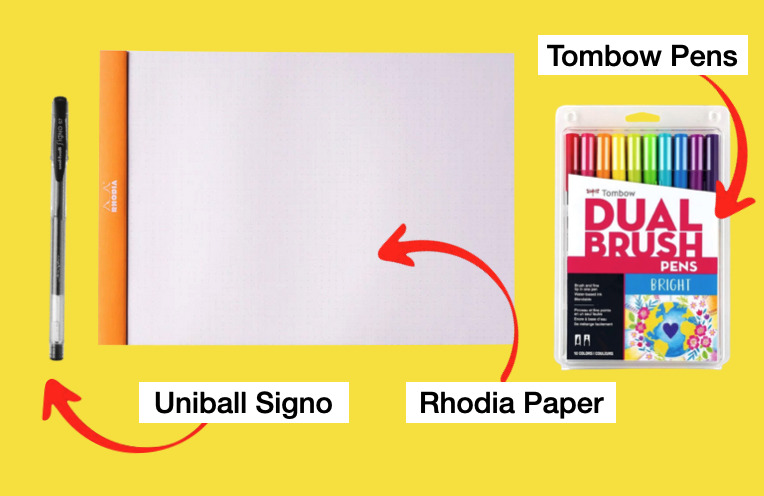
I mentioned this before, but it’s important to repeat it: don’t go cheap with your mind mapping tools. Invest in good pens and paper. My favourite pens for mind mapping are uniball signo pens (0.7 tip) and Tombow paintbrush pens. Regarding paper, I love using Rhodia paper (it feels like your mind mapping on butter).
It may sound a little dramatic, but mind mapping changed my life. I used to read books and then feel frustrated that I couldn’t retain much information. But now, I have a strategy I can easily use to help me understand and remember complex ideas. This gives me confidence when it comes to learning new skills and information.
I encourage you to be playful with this strategy. Don’t get too hung up on how your drawings look. Your top priority is to leave perfectionism at the door and have some fun. Because when it comes to mind mapping, done is better than perfect.
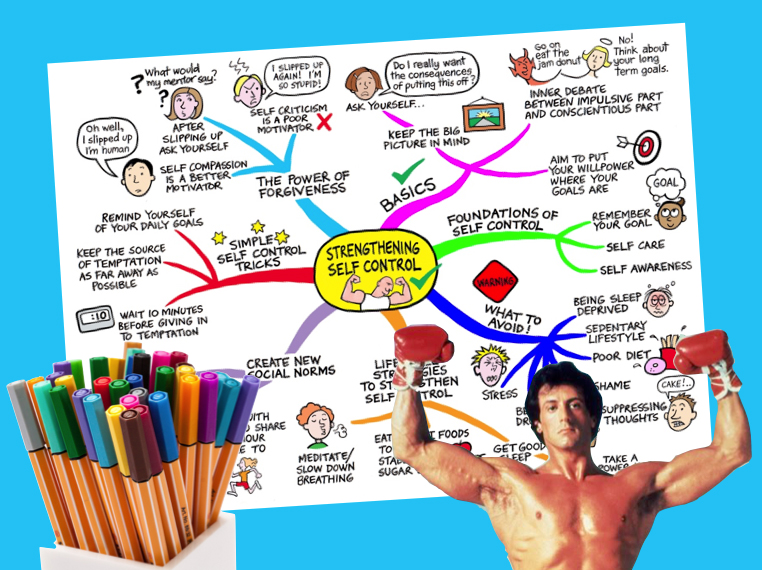
The funny drawings, the colour, and creativity can transform any dry subject into something that’s interesting for the brain.
But mind mapping is also a great life strategy. You can use it to create plans, capture ideas from books, set goals, clarify your thinking, organise your finances, and work your way out of messy situations.
Below I explore some different ways you can use mind maps in your day-to-day life.

Do you ever read books and then feel frustrated when you can’t remember much from them?
This is why I mind map out every non-fiction book that I read.
I know that there are limits to my memory. If I want to be able to extract ideas and strategies from a book and apply them to my life, I’m going to need to create mind maps.
There are two ways you can mind map a book:
1) You can mind map as you read: this forces you to slow down and really think about the ideas. I highly recommended doing this if the content is really complex. But this approach can be slow going!
2) You can mind map once you’ve finished reading: I use mini post-it notes to tab key ideas as I read. Once I’ve finished reading the book, I go back and mind map out the tabbed ideas. This way I have some perspective and can identify what’s important and what’s not (rather than assuming every sentence is important and needs to be mind mapped).
After I’ve finished mind mapping the book, I select a strategy that I’ve captured on the mind map to test out.
My husband has always been amazed at how I can take ideas from books and apply them to my life. But there’s no magic to this. I’m able to use lots of different strategies because mind mapping helps me to understand and remember them.
Let’s face it, if you can’t remember a strategy, you can’t use it!

Let’s say you have a test or exam coming up. Here’s how you can use mind maps to effectively prepare . . .
Push your notes and books to the side (you can’t look at them). Now grab a blank sheet of paper. Set a timer for 5 minutes and try to create a mind map on the main ideas you can remember.
Don’t try to make these mind maps look pretty. You’ve only got 5 minutes, so scribble and draw out as much as you can remember.
Once you’ve exhausted your memory, pull out your notes and pick a different coloured pen. Take a look at your messy mind map: What did you get right? What did you get wrong? Where are the gaps in your knowledge?
This strategy is called Active Recall and it’s the most effective way to retain information. You can read more about it here.
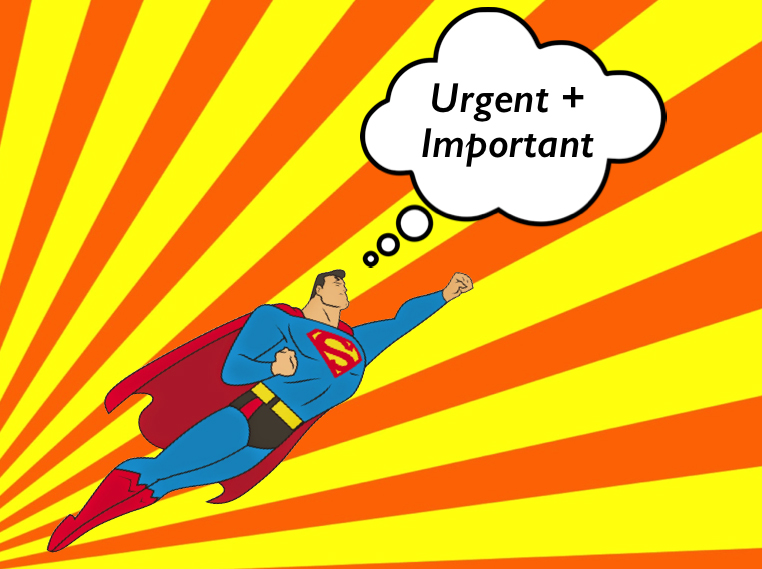
When you feel overwhelmed by life, everything can feel urgent and important. But not everything is urgent and important. A little prioritisation can save you a lot of stress and drama.
Grab a big sheet of paper, draw a circle in the middle, and write inside it Stuff to do. Now get everything out of your head and on to the page!
Once you’ve finished your mind map, look over all the tasks.
If a task is important, give it a tick.
If a task is urgent, circle it.
Focus your energy on knocking off the tasks that have ticks and circles around them (they are urgent and important).

Research shows the more connected you are to your Future Self, the more committed you will be to achieving your goals and the wiser decisions you will make in the present.
Draw a circle in the middle of page and write inside it My Future Self. You can create branches for your Future Self in:
• 3 months’ time
• 6 months’ time
• 1 year’s time
• 3 years’ time
• 5 years’ time
Then off each of these main branches, write down your goals. What do you want to have accomplished by this time?
As Dr Benjamin Hardy states in his book Be Your Future Self Now:
“The clearer you are on where you want to go, the less distracted you’ll be by endless options.”
Note: Imagining your Future Self is not an easy thing to do. We are terrible at imagining where we are going to be in the future. So, don’t overthink it. Just get some ideas down on paper. As you gain more clarity around your goals and values, you can always add extra branches to your mind map.
I’ve found mind mapping to be a fun and effective way to capture, organise, and retain information. Even if I never look at the mind map again, the process of getting ideas down on paper makes a big difference. It helps me to feel more in control and on top of things.
If you need some clarity in a particular area, stop ruminating. Pick up a pen and start mind mapping!

When you first test out this strategy, it can feel clunky and awkward. It requires a bit of mental effort to get going.
Why can it feel hard to start mind mapping?
Because it isn’t a habit (not yet anyway). Once mind mapping becomes a habit, it can feel easy and deeply rewarding.
But how do you get to that point where mind mapping feels easy? Even fun to do?
In this article, I will explore how you can create a habit of mind mapping. I’ll show you how to remove any friction or pain points, so it’s a lot easier to put pen to paper and start absorbing ideas.
Let’s start by looking at what gets in the way and stops a lot of people from creating mind maps in the first place. I’ll also share some strategies you can use to overcome each of these barriers.

When you look at a mind map with all the pictures and different colours, it looks like something that would take a fair amount of time and effort to create.
And if you’re comparing mind mapping to the time it takes to just read your book passively, then yes, mind mapping will take more time. But you need to appreciate that reading your book passively is not a particularly effective way to learn. In contrast, mind mapping is super effective.
One of the common time traps people fall into is they try to make their mind maps look like works of art. If you can lower your standards and allow yourself to make a mess when you mind map, this will speed up the process.
Another time trap is trying to mind map as you read. When you mind map sentence by sentence this can feel really slow! I find it’s much faster to just read and tab key ideas that are worth mind mapping later on. Once I’ve finished reading either the chapter or book, I then commence the mind mapping process.
Some people get really hung up on the way their mind maps look. They can’t stand looking at messy pictures and scribbled words. If that’s you, then perhaps you could take your drawing skills to the next level with a little practice and some illustration lessons. But it’s really not necessary.
Mind maps are not there to look pretty. They are there to help you learn. Personally, I am a big fan of badly drawn mind maps. If you look at my mind maps from university, they aren’t exactly easy on the eye. But they helped me to understand and memorise key ideas. And that’s what matters most when it comes to learning.
Here’s a simple hack: invest in a set of nice, vibrant coloured pens. A bit of colour on the page will make your mind maps more visually appealing and will compensate for any ugly stick figures on the page!

Mind mapping is straightforward and simple to do. You draw a central image, some curved lines, a few pictures, and write down key ideas. That’s it!
It’s not something you need to read a book about. You don’t need to enrol in a 10 week program to do this.
If you want some pointers, check out my free Mind Mapper’s Toolkit. It’s a quick and easy read.
It’s important to realise that the first time you engage in any new behaviour, it will feel a bit strange and uncomfortable. You may feel a bit clumsy and awkward. You may have questions, “Am I doing this right?”. All of this is normal and to be expected.
Even something as simple as the pen you mind map with can make or break this strategy. You’ve probably noticed that some pens don’t feel pleasant to write and/or draw with.
For instance, I’m not a fan of the popular Sharpie pen range. I don’t like the way these pens bleed through the page. And I really don’t like the way they smell.
These may seem like minor issues, but they’re not. Your mind mapping experience will be diminished by a pen that doesn’t feel good in your hand or on the page. And any behaviour that feels unpleasant is much harder to sustain.
I’ve since ditched my sharpie pens. I’m now using non-toxic Tombow paintbrush pens. As far as coloured pens go, I won’t lie, these pens are pricey! But you can hunt around and find them online for $25 cheaper than in Officeworks.
What I love about these pens is they are super easy to use, feel nice to strike across the page, and they won’t leave you with a splitting headache!
Here are some things that have really helped me to firmly establish this habit in my life:
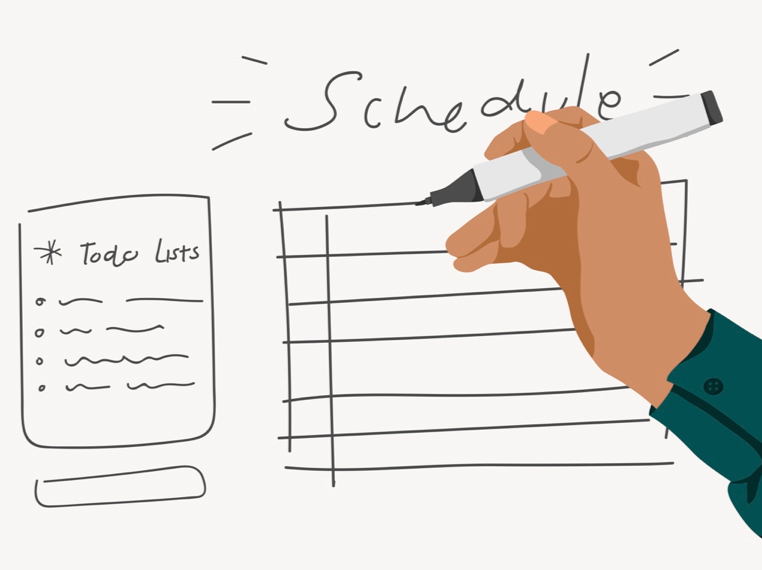
When is the best time for you to mind map? Where in your day can you easily slot in a 15 minute mind mapping session?
I like to mind map when I feel fresh and mentally alert (first thing in the morning).
Find an activity that you do every day without fail (e.g., having a shower, eating breakfast or dinner) and use that to prompt you to start a mind mapping session.
For instance, after I get up and have a drink of water, that’s my cue to sit down and start mind mapping.
Before you start your session, set yourself up with everything you need. I like doing this the night before my morning mind mapping sessions.
Just before I go to bed, I make sure my visual art diary is open on a fresh page, my pens are laid out, my gravity cube timer is within arms reach, and the book I am mind mapping is open on the page I need to start working from. The next day all I need to do is sit down, flip the gravity timer, pick up a pen, and away I go!

What’s one thing that can slow down the mind mapping process?
Technological distractions.
You probably already have a sense of the things that tend to derail you. Create a buffer between you and those things. For example, the biggest distraction for me is my phone.
How do I deal with this?
Before I start mind mapping, I put my mobile phone on silent and lock it in a kitchen safe. This signals to my brain that my phone is off limits and it’s time to knuckle down and focus on my work.
Don’t wait until you feel pumped and inspired to start mind mapping. Set a timer for 15 minutes and start mind mapping (regardless of how you feel).
If you miss a day, don’t beat yourself up. It’s no big deal. Just say to yourself, “Tomorrow is a new day. I’ll get back into mind mapping then”.
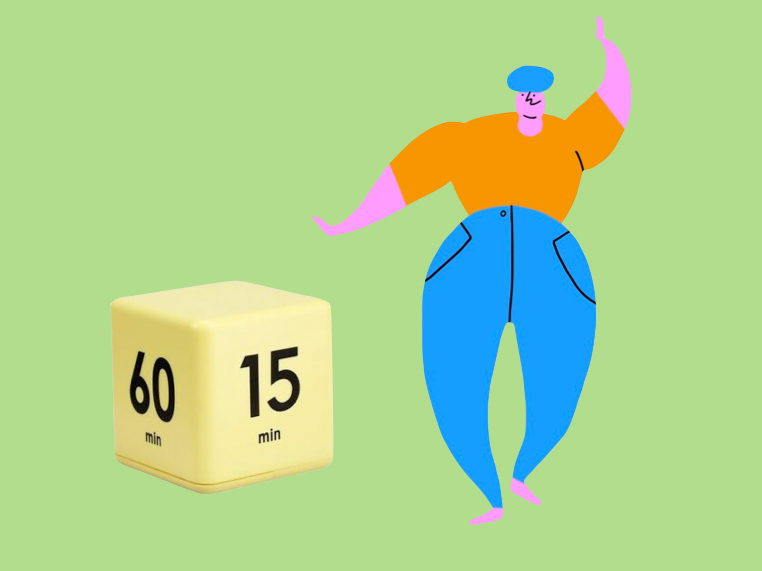
When the timer goes off at the end of your mind mapping session, say to yourself, “Good job!”. Do anything that makes you feel instantly good. I often clap my hands and give myself a pat on the back. According to Professor BJ Fogg this is the secret to wiring in any new habit. You need to instantly release a positive emotion.
I mentioned this before but it’s important to say it again: don’t go cheap when it comes to the tools you use to mind map with. Invest in good pens. My favourite pens for mind mapping are Muji Japanese Pens (Black) and Tombow paintbrush pens.
It may sound a little dramatic, but mind mapping has changed my life for the better. I used to read books and feel so frustrated that I couldn’t retain much information at all. But now I have a strategy I can easily use to help me understand and remember complex ideas. This gives me an incredible sense of confidence when it comes to learning new skills and information.
I encourage you to have a play with this strategy. Don’t get too hung up on how your drawings look. But do stick at the strategy for long enough to see if it makes a difference to your learning experience.
Dr Jane Genovese delivers interactive sessions on learning to learn, combating procrastination, exam preparation, how to focus in the age of distraction, habit formation and much, much more!
Get FREE study and life strategies by signing up to our newsletter:
© 2024 Learning Fundamentals